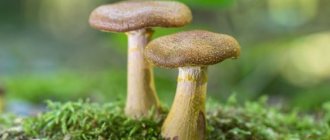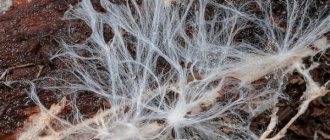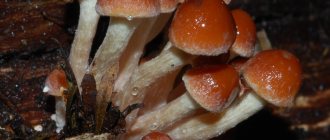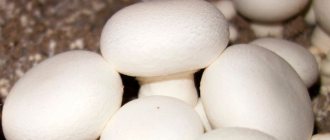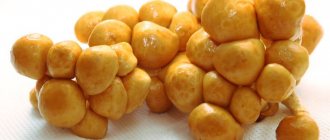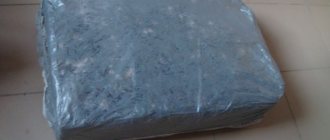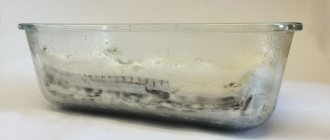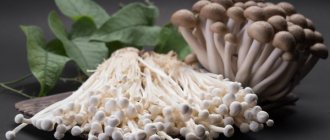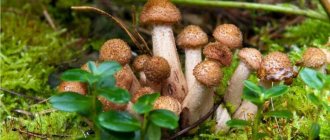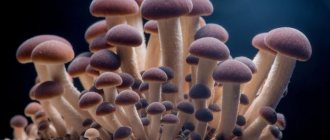| Hytholoma | |
| Hyfoloma fascicular | |
| Scientific classification | |
| Kingdom: | Mushrooms |
| Separation: | Basidiomycetes |
| Class: | Agaricomycetes |
| Order: | Agaricales |
| Family: | Strophariaceae |
| Genus: | Hytholoma (Pt.) P. Kumm. (1871) |
| Variety | |
| See text | |
| Synonyms[1] | |
| Naematoloma P.Karst. (1880) | |
Hytholoma
It is a genus of fungi which are quite well known for their common occurrence of tufts of sulfur (
Hypholoma fascicularis
) on tree stumps in temperate woodlands.
Species of this genus are easy to recognize because the dark spores create a characteristic greenish effect on the yellow cap underside. Hyfoloma
means "thread mushrooms" because of the thread-like veil that connects the cap to the stem when young and for the tufts of rhizomorphs that emanate from the root base.[2]
Other known species are H. capnoides
and
H. lateritium
.
What kind of mushrooms are suitable for pickling?
Almost all mushrooms can be salted: porcini, boletus, aspen, champignons, experience and many others.
But it is best to pickle tubular mushrooms. In our country, there are about two hundred species of mushrooms that can be eaten, but only fifty-seven species are allowed for industrial preparation.
Scientists have divided all mushrooms into four categories:
- The first and second categories are mushrooms that can be eaten after slight heat treatment;
- The third and fourth categories can also be eaten, but only after long soaking or many hours of digestion of all harmful substances.
The second category contains:
- tubular mushrooms, such as boletus, boletus and aspen mushrooms.
- Lamellar mushrooms, such as champignons, milk mushrooms and cap mushrooms.
But the favorite mushrooms, russula, honey mushrooms, chanterelles and other popular mushrooms, which are loved by many, belong to the third and fourth categories and are considered conditionally edible.
Honey fungus (Hypholoma capnoides)
Other names of the mushroom: False honey fungus sulphuroplate Poppy honey fungusFalse honey fungus poppyHyfoloma poppyHyfoloma ocher-orange
Synonyms:
Honey fungus (lat. Hypholoma capnoides) is an edible mushroom from the genus Hypholoma of the Strophariaceae family.
Cap of the honey fungus: 3-7 cm in diameter, from hemispherical in the youngest mushrooms to convex-prostrate in maturity, often with remnants of a private cover along the edges. The cap itself is hygrophanic, its color strongly depends on humidity: in dry mushrooms it is dull yellow with a richer middle, in wet ones it becomes brighter, light brown. As it dries, it begins to lighten symmetrically at the edges. The cap flesh is thin, whitish, with a faint smell of dampness.
Blades: Frequent, adherent, white-yellowish in young fruiting bodies; as they mature, they acquire the characteristic color of poppy grains.
Spore powder: Brown-violet.
The leg of the honey fungus is 5-10 cm in height, 0.3 - 0.8 cm in thickness, cylindrical, often curved, with a quickly disappearing ring, yellow in the upper part, rusty brown in the lower part.
Distribution: Honey fungus is a typical tree mushroom. Its fruiting bodies grow in bunches on stumps and on roots hidden in the ground. It grows only in coniferous forests, most often on pine and spruce, both in the lowlands and high in the mountains. Particularly abundant in mountain spruce forests. The honey fungus is common throughout the temperate zone of the northern hemisphere. It can be collected from spring to autumn, and often during mild winters. It grows like a honey fungus, in large clumps, occurring perhaps not so often, but quite abundantly.
Similar species: Several common species of the genus Hypholoma are similar to the honey fungus, as well as, in some cases, the summer honey fungus. This is primarily a poisonous false honey fungus (hypholoma) sulfur-yellow with yellow-green plates, a cap with sulfur-yellow edges and sulfur-yellow flesh. Next comes the false honey fungus - brick-red hypholoma (H. sublateriiium) with yellow-brown plates and a brown-red cap, growing in summer and autumn in bunches in deciduous forests and outside the forest, especially on the stumps of oak and beech. Even without knowing the mushroom, one can only distinguish Hypholoma capnoides from the sulfur-yellow honey fungus (Hypholoma fasciculare) only by formal characteristics: it has green plates, while the sulfur-plastic one has poppy-gray ones. The rooted hypholoma (Hypholoma radicosum) mentioned in some sources, in my opinion, is completely different.
Edibility: Honey fungus has a reputation as a good edible mushroom. In my opinion, it is very similar to summer honey fungus; old specimens acquire a kind of musty, damp taste.
Video about the mushroom Honey fungus:
Notes Honey fungus is a good edible mushroom with blue-gray, poppy seed-colored plates, a yellow-brown cap, whitish flesh and a pleasant taste.
For me, the honey fungus was and remains the “second summer honey fungus.” When they introduced us, they told me this: here’s another summer honey fungus that grows on pine stumps. I believed it, which, however, I still don’t regret. And what?..
Photo of the mushroom Honey fungus
from questions in recognition:
LAT
Characteristics:
| Group: | Lamellar |
| Records: | White, brownish-gray |
| Color: | Yellow or brown-yellow, bright orange, brown |
| Info: | The hat changes color when wet |
Taxonomy:
| Department: | Basidiomycota (Basidiomycetes) |
| Sub-department: | Agaricomycotina (Agaricomycetes) |
| Class: | Agaricomycetes (Agaricomycetes) |
| Subclass: | Agaricomycetidae (Agaricomycetes) |
| Order: | Agaricales (Agaric or Lamellar) |
| Family: | Strophariaceae (Strophariaceae) |
| Genus: | Hypholoma (Hypholoma) |
| View: | Hypholoma capnoides (Sulphurous honey fungus) |
The mushroom is edible, classified in the 4th taste category.
Collection rules
Collecting Hypholoma cephaloforma should be done with extreme caution, as it has a poisonous counterpart - the sulfur-yellow honey fungus. After the mushroom picker is convinced of the authenticity of the species, it can be carefully unscrewed from the soil, being careful not to damage the mycelium. The formed hole should be covered with moss or forest litter. The fruiting bodies of this variety are quite fragile, so they should not be placed in the same basket with their larger relatives.
Important! It is not recommended to uproot the fruits, since such actions destroy the ungrown mushroom crop of this year and subsequent years.
Appearance of sulfur-yellow false honey
The cap of the sulfur-yellow false mushroom is convex, with a diameter of up to 6 centimeters; when the mushroom matures, the cap straightens a little. The top of the cap is yellow, on the top there is a slight reddish tint. The edges of the cap are yellow-green. Remnants of the blanket may be visible along the edges of the cap on the underside.
The plates are adherent, olive, lemon-gray or yellow in color. In young specimens, the tone of the plates is sulfur-yellow, in old ones they become gray-violet, and when they decompose, they become almost black.
The leg is yellow or yellow-green. Young specimens may have a ring on the leg - marks from the film. In adult specimens, the leg is cylindrical, hollow inside, with a well-defined brown tint at the base. The pulp of the sulfur-yellow honey fungus is very bitter with an unpleasant odor.
Places of growth of sulfur-yellow false honey mushrooms
These mushrooms grow in forest and mountainous areas. They usually live in bunches or groups. Favorite places of growth are old stumps and half-rotten trunks of coniferous and deciduous trees. Sometimes false heels can grow at the base of living trees, but most often they are located on trees that are broken and lying on the ground.
False honey mushrooms often settle near edible honey mushrooms. You can often notice how autumn honey mushrooms grow, tightly squeezed on all sides by dangerous doubles. The fruiting season for sulfur-yellow false honey mushrooms is August-September, but they can appear earlier, and in the warm season they can be found as early as October and even November.
Doubles of sulfur-yellow false honey
Even poisonous mushrooms have doubles. The edible and tasty look-alikes are of greatest interest, because if you confuse the sulfur-yellow honey fungus with them, you can get seriously poisoned.
Edible honey fungus is very similar to its poisonous counterpart. The plates of edible honey mushrooms do not have a green tint. At a young age, the plates of honey mushrooms are white or cream. You can also recognize false fungus by a faint ring on the stalk, but old mushrooms often do not have a ring. In addition, the edible autumn honey fungus also has a ring on its stem.
The sulfur-yellow false honey fungus or poppy mushroom is also an edible mushroom, which can be confused with the sulfur-yellow false honey fungus. The cap of the sulphurous false frog is convex, becomes prostrate over time, and its color is brown, red-brown or yellow. The plates are creamy yellow or whitish when young and then become bluish-gray or darker. There is no sulfur or green tint at all. There is no ring on the leg either. Seroplasty false honey funguses are often left in the forest, because they are afraid of confusing them with their poisonous counterpart.
The yellow-red honey fungus has a vague resemblance to the sulfur-yellow false honey fungus. The spindlefoot collibia is also an inedible mushroom, and it is very similar to the sulphur-yellow fungus.
How to avoid getting poisoned by sulfur-yellow fungus?
The mushroom picker should be alerted by the green or olive tint on the cap, and especially on the plates and the upper part of the stem. The sulfur-yellow color of this mushroom can hardly be considered as a distinctive feature of the toadstool. It is better to pass by a dubious mushroom and collect only familiar mushrooms. A mushroom picker must have one hundred percent confidence in the mushrooms he collects.
Poisoning by sulfur-yellow honey fungus
Doctor of Medical Sciences and head of the intensive care unit Musselius in the book “Poisonous Mushrooms” described the symptoms of poisoning by sulfur-yellow mushrooms. These mushrooms contain resin-like substances - ketones and aldehydes, which irritate the gastrointestinal mucosa. The toxic effect can be very serious. In addition, some of the chemicals are absorbed into the blood and poison other organs.
A severe form of poisoning is most often observed when taking a very large amount of mushrooms, especially in the elderly or children, or if there are additional concomitant health problems: chronic hepatitis, hypertension, coronary heart disease, diabetes mellitus, etc. In rare cases, extremely severe poisoning occurs, even death is possible.
It is worth paying attention to the fact that after the sulfur-yellow false foam enters the stomach, acute gastroenteritis develops; if the first signs of this disease appear, immediately call an ambulance. The specialist receiving the call will tell you what actions should be taken before the medical team arrives
Review
Warts or papillomas are small, benign growths on the skin that can have different shapes, colors and are associated with the influence of the human papillomavirus (HPV).
Most people have had or will have warts. They appear more often in children and adolescents than in adults. The growth of warts is associated with the action of the human papillomavirus, which stimulates the division of epithelial cells and excessive formation of keratin, a protein that gives the skin hardness and roughness. However, not everyone infected with the papilloma virus develops any manifestations, including warts. In most cases, the immune system copes with the infection, preventing the development of symptoms of the disease.
Warts can be of different shapes and form one at a time or in groups. Certain types of warts tend to appear on certain parts of the body. For example, plantar warts sometimes appear on the feet, and filiform warts (papillomas) in women and men are more common on areas of the body with delicate and thin skin.
Warts are not considered highly contagious, but can be transmitted by contact (skin touching). Infection can also be transmitted indirectly through contaminated objects or surfaces, such as a pool floor. You are more likely to become infected if your skin is damp or damaged. Several weeks or even months may pass between infection and the formation of a wart.
Warts are benign growths but can resemble some types of cancer. Sometimes it is difficult to independently distinguish them from more dangerous skin formations. If in any doubt, it is better to consult a doctor before taking any self-medication measures.
In most cases, warts are harmless and go away on their own. How long it takes for the wart to disappear depends on each individual case. It can take up to two years for the body to get rid of the viral infection, at which time the wart will also disappear. If you want to speed up the process or the wart causes discomfort, there are various methods for removing warts and papillomas, both at home and with a doctor.
Description of honey fungus seroplate
The diameter of the cap ranges from 2 to 8 centimeters. Young sulphur-plated false honey mushrooms have convex caps, dirty yellow or pale yellow in color, and the plates are covered with a white film.
As the mushroom matures, the cap becomes less convex, and its color changes to brown-orange with brown spots, while the film breaks and hangs in white flakes. In damp weather the cap becomes sticky.
The plates are often spaced, narrow, fawn in color; with age they become smoky gray, and in older specimens they become gray-brown or purple-brown. The plates are adherent to the leg.
The leg is shaped like a cylinder. Its diameter is about 0.5 centimeters, and its height reaches 10 centimeters. The leg can be curved or straight; there is no ring on it. At the top of the leg the color is light yellow, and at the bottom it turns brown.
The flesh of the cap is pale yellow, sometimes white, thin, non-bitter, and practically odorless, but in older specimens a pungent smell of dampness appears. The spores are bluish-gray in color.
Places of growth of sulphurous honey fungus
These mushrooms are distributed mostly in the temperate climate of the Northern Hemisphere. Most often they can be found in coniferous mountain forests, and in deciduous forests they are extremely rare.
Seroplate honey fungus grows mainly on coniferous stumps, on roots and on rotting trees. These mushrooms can be found from June to November, but the peak of mass ripening is observed from September to October. Seroplate honey fungus settles in large colonies; they grow alone very rarely.
Some types of fungi form mycorrhiza - a kind of symbiosis with plants.
Sulphur-shaped false honey funguses are symbiotes. Their mycelium envelops the roots of trees and penetrates inside, which is how the mushrooms feed. For the plants themselves, such a union is also useful, since with the help of mushroom roots they receive minerals from the soil. Pine trees grow strong and tall if they form beneficial alliances with mushrooms. And when false honey mushrooms settle on diseased trees, they destroy them. That is, in fact, the sulphurous honey fungus are orderlies. Because they destroy old trees in the forest.
Reproduction of sulphurous honey fungus
Like all mushrooms, reproduction in the sulphurous honey fungus occurs with the help of spores. The shape of the spores is elongated, the surface is smooth, the color of the spore powder, like that of many strophariaceae, is bluish-gray or dark purple.
The spores are attached to plates. The number of spores is huge. They are carried by the wind in different directions. When the spores land on the ground, mycelium begins to form.
Edibility of honey fungus
Seroplate false honey fungus belongs to the false edible mushrooms. In general, representatives of the strophariaceae family are classified as poisonous mushrooms, but some species can still be eaten after proper processing.
In terms of taste, the sulphurous honey fungus belongs to the 4th category. This mushroom is suitable for preparing a variety of dishes, but it is not added fresh to food, but boiled for 15 minutes. In addition, sulfur-plated honey fungus can be salted, pickled and dried. The smell and taste of this mushroom are soft and pleasant.
It is recommended to eat young honey mushrooms, as older specimens develop an unpleasant odor. It is advisable to collect only the caps, since the legs, like other mushrooms, are too hard.
In Western Europe, the honey fungus is a popular mushroom; mushroom pickers collect it with great pleasure.
Similar species
False honey fungus can be mistakenly confused with other mushrooms of the genus Hyfoloma:
- The brick-red false honey fungus got its name due to its characteristic color. This mushroom is not poisonous, but it is not eaten. Its distinctive feature is the yellowish color of the plate. The pulp is quite dense and tastes bitter;
- The sulfur-yellow false honey fungus is a poisonous member of the family; it can be distinguished by its green plates and sulfur-yellow flesh and cap;
- Galerina fringed, similar to the sulphurous honey fungus, is generally very dangerous, as it is deadly poisonous. It is distinguished by brown plates and rusty spore powder.
- The summer honey fungus differs from the gray-plated honey fungus in its light-colored flesh. His plates range from fawn to gray at different ages. There is no unpleasant odor or bitterness.
gribnikoff.ru
Endoscopic signs of rigid antral gastritis
The outlet section of the stomach is affected in isolation, which, due to hypertrophic changes, edema and spastic contractions of the muscles, is deformed, turning into a narrow tube-like canal with dense walls. This lesion is based on a chronic inflammatory process that affects all layers of the stomach wall, including the serous one. Characterized by persistent dyspepsia and achlorhydria. An endoscopic examination reveals a narrowing of the antrum, its cavity looks like a tube, does not expand with air at all, and peristalsis is sharply weakened. The mucous membrane is sharply edematous, swollen, with areas of severe hyperemia and deposits of mucus. As the disease progresses, motor-evacuation activity is impaired (a sharp weakening of peristalsis), sclerosis of the submucosal and muscular layers develops, and a persistent rigid deformity develops with a significant shortening of the antrum of the stomach.
[], [], [], [], [], [], [], [], [], [], []
Description of the seroplate pseudofoamum
The cap of this type of mushroom has a diameter of 2-8 cm. Its color depends on the humidity and age of the mushroom body: in dry mushrooms it is light yellow with a rich center, in wet mushrooms it is light brown. There is a whitish film on the plates.
In adult mushrooms, the cap becomes even, and its shade changes to orange-brown with dark spots. The film is destroyed and hangs on the body in the form of whitish flakes. In wet weather, the surface of the cap acquires a sticky structure.
Seroplate false honey fungus can have a straight or slightly curved stalk, on which there are practically no rings. Its upper part is painted in a light yellow tint, and its lower part is brown.
The flesh of the mushroom cap is thin, white or light yellow, almost odorless. However, old mushroom bodies have a distinct smell of moisture. The spores are distinguished by a gray-blue color.
Malignant neoplasms of the skin
The most dangerous types of skin tumors are malignant. They differ from benign ones in that they grow quickly, penetrate into surrounding tissues and metastasize to areas distant from the lesion. The body does not control cell division in such tumors, and they themselves lose the ability to perform their original functions.
Signs of degeneration of a benign tumor into one of the types of malignant neoplasms on the skin:
- rapid or sharp increase in tumor size;
- the appearance of ulcers, bleeding;
- spread to adjacent tissues;
- change in color or degree of pigmentation saturation.
The main types of malignant skin tumors:
- Melanoma is the most common type. Most often it arises from moles due to injury or excessive exposure to ultraviolet radiation.
- Basal cell carcinoma is a squamous cell skin cancer made from atypical cells of the basal layer of the epidermis. Outwardly it looks like a white nodule with a dry crust on the surface. As it progresses, it increases in width and turns into a deep ulcer.
- Kaposi's sarcoma. It consists of multiple tumors of purple, violet and lilac color. They combine and turn into ulcers.
- Liposarcoma is a malignant tumor of adipose tissue that occurs against the background of lipomas and atheromas.
- Fibrosarcoma is a neoplasm of connective tissue, most often of the lower extremities. It has a dark blue-brown color and can protrude noticeably above the skin.
Experts recommend removing both benign and malignant tumors. This is the optimal treatment method if there are no contraindications to it. In the case of benign neoplasms and precancerous conditions, with timely treatment, the prognosis is favorable.
Malignant tumors require more effort and the prognosis may not be as favorable, especially if metastasis has already occurred
Therefore, if you suspect malignant processes, it is important to consult a doctor as soon as possible.. April 5, 2020
April 5, 2020
Honey mushrooms
If August marks the peak of collecting tubular mushrooms, then in September you just have time to send lamellar mushrooms and, above all, autumn honey mushrooms into baskets and baskets. A whole army of mushroom pickers is looking forward to the season of their collection, because it is known that these mushrooms produce the maximum harvest by weight. Autumn honey mushrooms can first appear in separate places - on stumps and fallen trees, or they can grow immediately in vast forest areas. In the first two or three days they are tiny, about the size of a match or pin head. On the fourth day they can become the size of a ruble, and after a week (depending on the subspecies) the diameter of the cap will already be from 2.5 to 7 cm.
Endoscopic signs of Ménétrier's disease
Menetrier's disease (1886) is a rare disease, one of the signs of which is giant gross hypertrophy of the folds of the gastric mucosa. Changes can also affect the submucosal layer. Excessive growth of the mucous membrane is a manifestation of metabolic disorders, most often protein. Patients experience weight loss, weakness, edema, hypoalbuminemia due to increased release of albumin into the gastric lumen, iron deficiency anemia, and dyspepsia. An endoscopic examination reveals sharply thickened, convoluted folds (can be up to 2 cm in thickness). The folds are frozen, in contrast to hypertrophic gastritis, located along the greater curvature with a transition to the anterior and posterior walls of the stomach. The folds do not straighten out even with increased air insufflation. At the tops of the folds there may be multiple polyp-like protrusions, erosions, and submucosal hemorrhages.
Biopsy: pronounced hyperplasia of the surface epithelium, restructuring of the glandular apparatus.
Differential diagnosis must be made with infiltrative gastric cancer. Control at least 2 times a year.
[], [], [], []
Hyfoloma bordered: description and photo
| Name: | Hyfoloma bordered |
| Latin name: | Hypholoma marginatum |
| Type: | Inedible |
| Taxonomy: |
|
Hyfoloma fringe is an inedible member of the Strophariaceae family. It grows singly or in small families among coniferous trees, on rotting needle-like substrate. It is rare and bears fruit throughout the warm season. In order not to make a mistake in your choice during mushroom hunting, you need to familiarize yourself with the external characteristics, view photos and videos.
What does a bordered hypholoma look like?
Getting to know this forest dweller must begin with a detailed description. The cap has a hemispherical shape, which straightens as it matures, leaving a small hill in the center. The surface is matte, ocher-yellow, the edges are painted in lighter colors. The bottom layer is covered with thin plates of light lemon color. Reproduces by black-purple spores. The leg is thin and long.
The mushroom is inedible and causes food poisoning
Where does hyfoloma bordered grow?
Hyfoloma fringe is a rare species, growing in single specimens or small families in coniferous forests. It can also be found on rotten wood, in needle-like substrate, and on the stumps of coniferous trees.
Is it possible to eat fringed hypholoma?
Hyfoloma bordered belongs to the inedible category. When consumed, it causes gastric poisoning. Therefore, in order not to harm yourself and your loved ones, you need to know the description and carefully look at the photo.
Hyfoloma fringed, like any inhabitant of the forest, has similar doubles. Such as:
- Poppy - belongs to group 4 of edibility. You can recognize this specimen by its small ocher-yellow cap, smoky plates, and thin long yellowish-whitish stem. The light ocher pulp has a pleasant taste and aroma. It grows in large families on stumps and rotten coniferous wood. Fruiting is long, from May until the first frost.
Suitable for preparing fried and stewed dishes
Despite the bitter taste, the mushroom is used in cooking
If a hypholoma bordered by negligence ends up on the table, then it is necessary to promptly recognize the signs of poisoning and provide first aid
Symptoms of poisoning
Hyfoloma fringed is an inedible representative of the forest kingdom. When consumed, it causes gastric poisoning. First signs:
- nausea, vomiting;
- diarrhea;
- epigastric pain;
- cold sweat;
- hypotension;
- constriction of the pupils;
- labored breathing.
First aid for poisoning
The reaction to toxins appears 1-2 hours after eating. If at least one sign appears, you need to immediately call a medical team and begin pre-medical care:
- Lay the patient down and free him from compressive clothing.
- Open the windows for fresh air.
- Induce vomiting by giving the victim a large amount of water.
- Give absorbents according to instructions.
- If there is no diarrhea, use a laxative.
- Place a warm heating pad on your stomach and limbs.
Conclusion
Hyfoloma fringe is an inedible forest inhabitant that grows among coniferous trees. Since the mushroom is not eaten as food, you need to know its external characteristics and, when you encounter it, do not pick it, but pass by.
Variety
- H. acutum
- H. aporum
- H. australe
- H. australian
- H. brunneum
- H. californica
- H. capnoides
- H. castilloi
- H. confusum
- H. dispersum
- H. elongatum
- H. epixanthum
- H. ericaeoides
- H. ericaeum
- X. eximium
- H. fasciculare
- H. flavorhisum
- H. flavovirens
- H. fragile
- X. frowardii
- H. laeticolor
- H. lateritium
- H. litorale
- H. marginatum
- H. murinacea
- H. myosotis
- H. ornellum
- H. peckianum
- H. peregrinum
- H. perplexum
- H. polylepidis
- H. polytrichi
- H. popperianum
- H. puiggarii
- H. radicosoides
- H. radicosum
- H. rickenii
- H. rubrococcineum
- H. solitarium
- H. subdispersum
- H. subericaeum
- H. subviride
- H. vinosum
- H. xanthocephalum
Seroplate honey fungus: where false mushrooms grow
The gray-plated false honey fungus belongs to the conditionally edible group of mushrooms and belongs to the Strophariaceae family. Its Latin name is Hypholoma capnoides. Its mushroom pickers are also called poppy or pine false fungus.
Description of the seroplate pseudofoamum
The cap of this type of mushroom has a diameter of 2-8 cm. Its color depends on the humidity and age of the mushroom body: in dry mushrooms it is light yellow with a rich center, in wet mushrooms it is light brown. There is a whitish film on the plates.
In adult mushrooms, the cap becomes even, and its shade changes to orange-brown with dark spots. The film is destroyed and hangs on the body in the form of whitish flakes. In wet weather, the surface of the cap acquires a sticky structure.
Seroplate false honey fungus can have a straight or slightly curved stalk, on which there are practically no rings. Its upper part is painted in a light yellow tint, and its lower part is brown.
The flesh of the mushroom cap is thin, white or light yellow, almost odorless. However, old mushroom bodies have a distinct smell of moisture. The spores are distinguished by a gray-blue color.
Where do they grow?
Most often, gray honey mushrooms are found in the Northern Hemisphere, in regions with a temperate climate. They grow in forests with coniferous trees, but can sometimes be seen in mixed forests. Among deciduous trees, poppy mildew rarely grows.
In most cases, these fungal bodies are found on tree stumps, on rotting tree trunks and roots in lowlands and hills. Mushroom pickers collect them from early summer to late autumn, but the peak ripening of fruiting bodies occurs in September-October. False honey mushrooms prefer to settle in large clusters; single fruiting bodies grow in rare cases.
Some varieties of fungi form symbiosis (mycorrhiza) with plants, and sulphur-type false honey fungi act as symbiotes. Their myceliums go deep into the root system of plants and provide constant nutrition to the fungal bodies.
This union is also useful for plants, since the roots of honey mushrooms deliver minerals from the soil to their rhizomes. As a result, pines grow tall and powerful. However, if gray honey mushrooms grow on unhealthy trees, the latter die.
How do they reproduce?
Like other varieties of mushrooms, gray-plated honey mushrooms reproduce through spores. They have a smooth surface and an elongated shape. The spore powder has a dark purple or gray-blue color.
The disputes are recorded on plates. They spread across the area with the help of the wind. After the spore falls on the surface of the earth, it begins to actively form a mycelium.
Edibility of honey fungus
Seroplate honey mushrooms are considered conditionally edible. Most mushrooms in the Strophariaceae family are poisonous, but some types, including gray honey mushrooms, can be used as food, but only after careful processing.
In terms of taste, this subspecies belongs to the fourth category. False foam is added to various culinary dishes, but before that it must be boiled for 15 minutes. At the same time, mushroom bodies can be dried, pickled and made into delicious pickles. Gray honey fungus is characterized by a pleasant and mild taste and aroma.
It is advisable to eat young fruiting bodies, because old mushrooms have an unpleasant odor. It is recommended to collect only mushroom caps, as their stems are too tough.
Similar species
This variety of mushroom can be confused with other representatives of the Hyfoloma genus. Most similar types:
- Brick-red false foam. This mushroom received this name for its specific color. The fruiting body is not poisonous, but it is not customary to eat it. The peculiarity of the brick-red variety is that its plates are yellow in color. The pulp is dense and bitter in taste, so dishes prepared from brick-red honey mushroom are not particularly appetizing.
When collecting sulfur-plated false honey mushrooms, you should be extremely vigilant, because Eating similar poisonous mushrooms can lead to extremely undesirable health consequences.
Endoscopic signs of chronic gastritis
The term chronic gastritis was first used by Broussais at the beginning of the 19th century. According to many gastroenterologists of the present time, chronic gastritis is asymptomatic in most cases. Visual assessment together with targeted biopsy makes it possible to correctly diagnose the form of chronic gastritis in 100% of cases, without a biopsy - in 80% of cases.
Endoscopic signs of chronic gastritis
- The folds of the mucous membrane are usually easily straightened with air, and only with severe swelling do they have a slightly thickened appearance at the beginning of insufflation.
- Color of mucous membrane. Normally, the mucous membrane is pale or pale pink. When inflamed, the color is bright, of various shades. If areas of normal mucosa are mixed with areas of inflammation - a motley mosaic appearance.
- On the mucous membrane there are often formations protruding above the surface from 0.1 to 0.5 cm in diameter. Can be single or multiple.
- Vascular drawing. Normally not visible. May be visible against the background of thinned mucosa.
- Mucus deposits indicate inflammation. It can be foamy, transparent, white, mixed with bile, and sometimes difficult to wash off with water.
[], [], [], [], []
